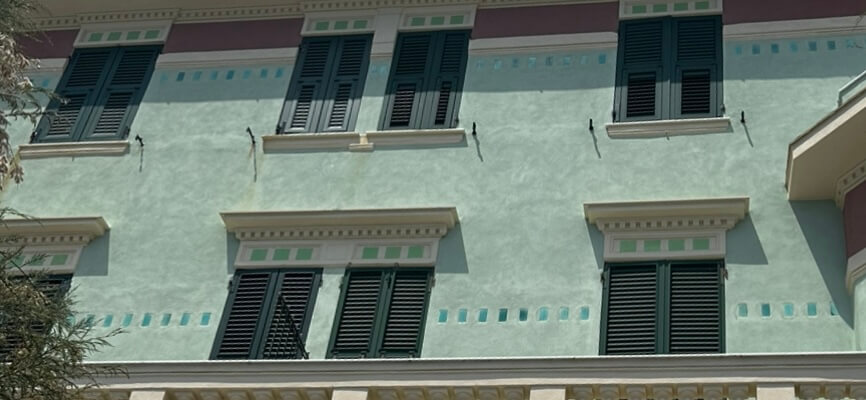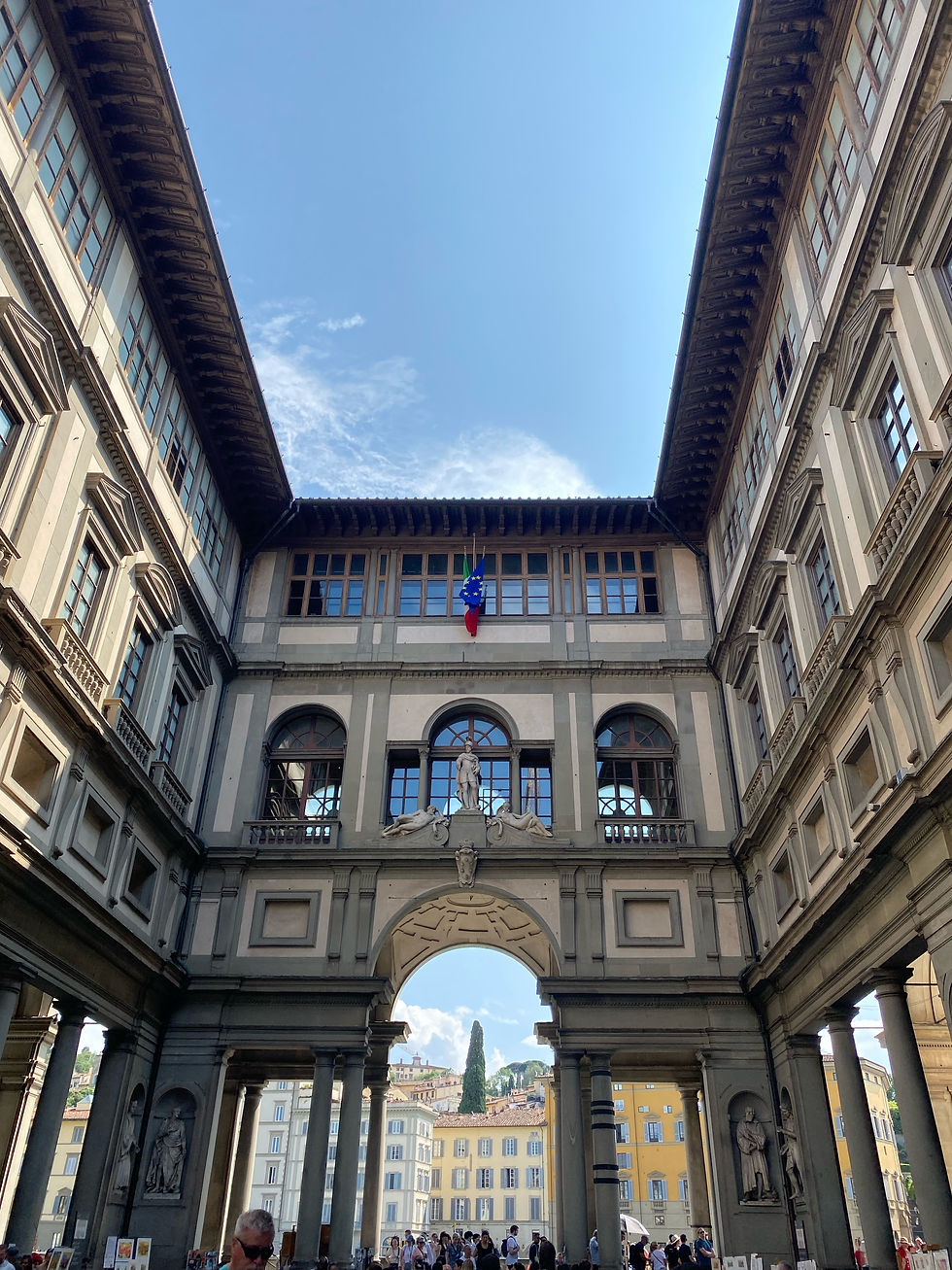The Sea of Green: A Look into the Windows of Italy
- Madison McClelland

- May 30, 2023
- 5 min read
By Madison McClelland

The Italian landscape is filled with an array of buildings and their details. When looking at monuments, it is easy to be drawn into the aspect of history. Once the town becomes more residential, outside of the places everyone visits, you can find hidden gems that connect to the lives of locals. If you just look up, you'll find something that graces the windows of the town, separating the lives of those who walk the streets to those who live within: shutters.
Behind the Blinds
Aesthetic appeal is one aspect, but shutters were used in a more practical sense. They even continue to be used in this way. Shutters were utilized for temperature control. The intense heat and seemingly never ending sun can cause the indoors to be just as hot as the outdoors. The shutters helped preserve any cool air as they were usually closed during the daylight hours and opened during the night. Through all the buildings of different time periods, this practice and the shutters have remained the same.
The Greeks are credited with the invention of shutters. The belief that shutters came to be in Ancient Greece is just another architectural advancement they contributed to. These shutters were made of marble, durable yet difficult. Wood was eventually incorporated into shutter designs. The appearance was enhanced and they were easier to maneuver. When shutters traveled to the rest of the Mediterranean, the wood took over. Shutters did not become common in homes until the eighteenth century. Painted shutters usually held importance behind the color, especially in places like Italy where they used arsenic.

Arsenic is naturally occurring in nature, but can also be released into the environment. Due to this fact, individuals would use this to their advantage. It was believed that arsenic held properties that could repel mosquitoes and other unwanted insects when used in paint. Turning a green color, many Italians used this for their windows with hopes that the arsenic would make any bug issues go away. Though it was proved that this was not the case, the green tradition was still upheld, along with the browns and grays. This allowed for a cohesive look among the buildings, and for some regions there is a law that makes it stay this way.
For the typical visitor, it may escape their mind as to why the shutters are painted this way. Visitor Julie Castillon was surprised at the mention of this fact. “Oh, I guess I never really pieced that together,” she realized. “Yeah, uh, there is a lot of green shutters. I think it's interesting that it was like a thought to paint the shutters that color and how it would keep bugs and stuff away,” she added.

Into the Details
Florence
Amongst the architecture that brings visitors into a picture of the Renaissance, Florence is decorated with buildings that hold locals and visitors. The shutters of these buildings complement the colors of each one. The buildings mainly utilize terracotta and ochre, or yellow based pigments. In turn, the green or brown of the shutters pair nicely. The city is bathed in neutrals, allowing for the occasional bright color, like the green shutters, to stand out.
The shutters differ slightly, but the majority maintain the rectangular shape that covers the window perfectly when closed. The windows are placed near each other, multiple on a single wall.
Visitor Raina Chehatli noticed this about the city. “I would say, looking at the buildings, what piques my interest is how close they are to each other and how that affects the social, like, aspects of their culture.” Side to side buildings, and side to side windows, pose an interesting question into the home life of local residents for Chehatli.

Most of the buildings are multiple stories, creating more rows and columns full of windows and their corresponding shutters. The dark green color is typically worn from the elements. Bits and pieces of brown peek through. This tends to be more noticeable when the shutters are closed rather than open. Attached with three hinges, the shutters have a beveled look to them to fit in the window and have the blinds further inward. This adds an aspect of depth and design to the shutters. There is also a protruding piece on the bottom, most likely used as a handle. The individual blinds are angled to keep the light and heat out, with the bottom leaning more forward than the top of it. This reverses when the shutters are open.
Venice
The major square in Venice, Piazza San Marco, plays into the traditional architecture of the time period. The piazza is full of white and gray, so moving outside brings more color into view. Here, the buildings begin to differ from those in Florence, including more pigments than the common yellow based colors of the city. One thing remains constant though: the shutters.

Shutters are on most windows, but the shapes and types seem to differ compared to those that were previously discussed. Some of the shutters maintain the rectangular shape. However, there are other shutters that are elongated to fit the frame of the window. These frames also tend to have a half circle attached to the top. This creates a beautifully sophisticated silhouette. The shutters on both frames adopt a collapsible feature. The shutters are split into two parts on both sides. When they are opened, one panel stays on the inside frame of the window, while the other extends outward to lay flat on the exterior of the building. There is less dimension on these shutters. They are just typically split into multiple rectangles with the handles higher on the middle of the outside panel. There is not a blinds component like those in Florence.
Cinque Terre
The landscape of Cinque Terre has been made famous for its beauty. If one looks closer, a detail of the buildings contributes to this, and is familiar. The same shutters that are seen throughout many Italian cities, including Venice and Florence, can be found in this location.
The color palette has only increased in vibrance for these buildings. The same yellow colors can be found here, but brighter hues have been adopted as well. Traveling between towns, visitors can get lost in a view of reds, pinks, and greens. Decorating these brightly colored buildings are shutters, ranging in greens, browns, and grays.

Castillon commented on this as well. “I think when you look at [Cinque Terre], it's striking almost,” she says. “It's so colorful and the water is so blue and, like you pointed out, the shutters help create that view. I understand why it's so visited and photographed.”
The shutters of Cinque Terre are similar to those in Florence. They have the blinds aspect in the center of the design. There are only two panels, one right and one left. The middle portion of the shutters are inward more than the base of the panel. There is a difference, however. The shutters are split into two or three vertical panels of blinds, depending on the size of the window frame. This allows the bottom of the shutters to be opened. The shade is still present but allows for air flow to occur more so than when the shutters are completely closed. For the taller, more elongated shutters, the middle and the bottom can be opened accordingly.
The Colors Above
The unique persiane, the green shutters, of Italy contribute to the look and appeal of Italian buildings. Establishing a practical and aesthetic use, the windows and shutters provide a look into the history of the city and the lives of locals. Whether you’re indoors with painted ceilings or outdoors with the plethora of windows and shutters, it may be important to keep one phrase in mind: always look up.



























Comments